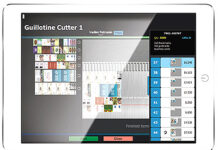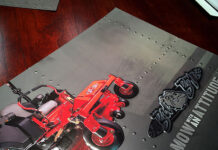by Jen Clark, PostPress

Basic preventative maintenance can go a long way toward keeping paper cutters working properly, especially when cutting difficult substrates. Regular maintenance can reduce production issues, said Bruce Peterson, president of Colter & Peterson, Paterson, New Jersey. “A machine always needs to be lubricated, and a paper cutter should have its oil and filters changed every 2,000 hours of use,” he said. “If the oil isn’t changed, it loses viscosity and begins to break down. That will lead to other issues.”
Regardless of the machine’s age, keeping it and the area around it clean also is important, not only to preserve the machine’s peak performance, but for operator safety as well. Oil on the floor, for example, can lead to injuries. “If there is dirt nearby, it should be cleaned up so it doesn’t mess with the machine. If an operator hears something that doesn’t sound right, that’s the signal to give us a call,” Peterson said. “It’s always better to catch something sooner rather than waiting until it’s too late.”
PostPress asked Peterson about cutting difficult substrates and the effects they can have on both blades and machines.
What should be kept in mind when cutting difficult substrates, such as plastic sheets, shiny UV coated sheets and sheets with embossing, etc.?
It depends on what kind of substrate it is, but using proper cutting techniques always is a good idea. Having the right clamping pressure is essential. The softer the paper is, the more pressure is needed, and it’s the opposite with harder paper. Never adjusting the clamp pressure eventually leads to cutting problems. Another thing to keep in mind is every printed sheet has a guide and gripper edge. It needs to be inserted into the machine properly with the correct pressure and program.
What types of blades should be used?
The majority of our customers who cut paper use blades made of 18-percent tungsten steel. It’s a harder steel and less susceptible to developing problems. By properly caring for it, this blade is capable of 60 to 80 hours of cutting time before needing to be replaced. If customers are cutting chipboard, I would recommend standard steel knives, which are a lower grade.
What effect does difficult substrates have on blades? What can be done so that the cutting blades last longer?
It varies. Tungsten steel blades work very well on fine, high-quality paper. It’s perfect for 70-80lb, 8-10-12pt board, coated stock and will last for 60-80 hours before it is gets dull and needs to be replaced. If operators notice that the blade is causing nicks in the paper, they should stop using it because it needs to be changed.
More people are switching to blades made from tungsten carbide, which is an even harder grade of metal than the ones with tungsten steel. These blades are more impervious to wear and tear and they could last five to 10 times longer and with less down time, depending on what type of material they are cutting, how often and other factors. The tradeoff is they cost three to five times more, they can be more brittle and susceptible and they don’t work well with glue. If you bind books, these are not the kind of blades you want.
The people who cut chipboard should stick with standard steel knives. Chipboard has a lot of foreign material inside, such as crushed rocks, stones and staples, that causes gradual wear and tear. If an operation is cutting different substrates, chipboard should be the last thing its operators cut for the day, just in case a problem develops that causes down time for the machine.
How often should blades get changed?
The stresses a dull blade places on a paper cutter are astronomical. It smashes material instead of cutting. It is an easy problem to solve – just keep the blade sharp. There are five early warning signs of a dull knife, including
- a rough or chipped cutting edge;
- a banging sound when cutting through a pile;
- the cut material sticks together;
- the cut edge is ridged or turned down; and
- inaccuracies in cutting, like overcuts and undercuts.
All machines today have cut counters. Operators can see how many cuts they are getting out of a blade. Clients may find that if they change the blade every 40 hours or approximately every 4,000 cuts, they are changing the blade in advance of it getting very dull, before it damages material or the machine.
Bruce Peterson is president of Colter & Peterson. As an independent distributor of paper cutters and paper handling equipment since 1932, Colter & Peterson has serviced, repaired and rebuilt all types of paper cutters from 20″ to 112″ in size, including Harris-Seybold, Dexter-Lawson, Polar, Wohlenberg, Challenge, Schneider, Prism and Saber. For more information, visit www.colterpeterson.com.




